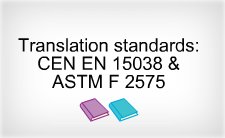How Translation Standards
Can Help Buyers of Language Translations

Two new quality standards for language translations were published in summer 2006: CEN EN 15038 entitled "Translation services - Service requirements" and ASTM F 2575 entitled "Standard Guide for Quality Assurance in Translation". One is the European standard and the other is the American. Both were welcomed by many translators.
However, translation customers are either unaware of these standards or do not think that the standards make a difference. Nevertheless, they are useful for users of translation services too. The standards can be a beacon on the road to a successful implementation of a project that involves translating materials into/from foreign languages.
Thanks largely to the Internet, the global language translation market has seen the explosive growth in past decades. Numerous new translators (both companies and individuals) enter the market and seek to attract customers. As a result, the competition for customers is fierce and the choice of translators is wide. How to select a translator that is right for you and how to proceed? Answers to these and similar questions can be found in the abovementioned standards.
The other aspect of globalization is that new clients, those who never before had to buy language translation services (including small and medium-sized enterprises, government agencies and private individuals), are now forced to deal with foreign languages. This means that they have to orient themselves with basic terminology and steps involved in translation of written materials (translating, editing, formatting, and proofreading). They should get to know how to prepare their translation project specifications and how to formulate their expectations. The CEN EN 15038 and ASTM F 2575 standards describe these points in detail.
The standards list quality requirements for translation services. Thus, the ASTM F 2575 states that, at a minimum, project management, translation, and editing tasks performed by highly qualified individuals at all stages should be considered the default to obtain a product that meets high quality standards.
The CEN EN 15038 and ASTM F 2575 standards can help customers get the quality product they need. The standards stress key principles for customers to follow:
- Select a translator proficient in both source and target languages with expertise in the subject matter of the source text
- Before the project begins, define project specifications and agree on them with the translator
- Adhere to the specifications at all stages of the implementation process
How to get the standards that regulate language translations
The European standard:
Go to a website of the European Committee for Standardization and make a search for EN 15038. In the search form, put EN 15038 into the "Standard reference" box. Click on the "Search" button. On the search results page, click on the "More" button. You will get a list of EU member countries' websites. Go to the website of your country and conduct another search for EN 15038. You'll get a page with the standard's overview and price. (The British standard is here)
The American standard:
The information about this standard is available on the ASTM International website
Didn't find what you were looking for? Use this search feature to find it.
Back to Parameters Page
Return from Language Translations and Standards Page to Home Page
_____________________________________________________________________ Website owner: Irina Lychak, self-employed freelance linguist, Russian translator, Ukrainian translator, Kiev (Kyiv), Ukraine